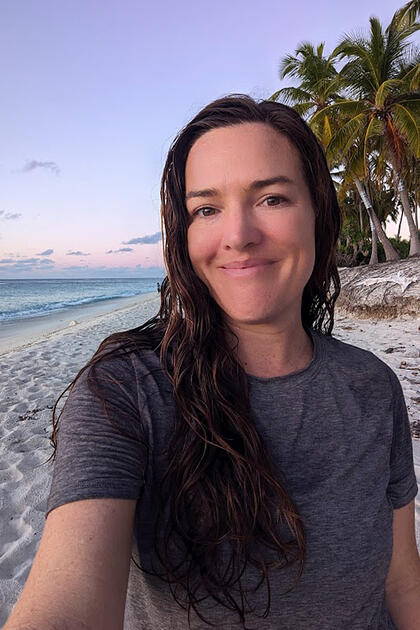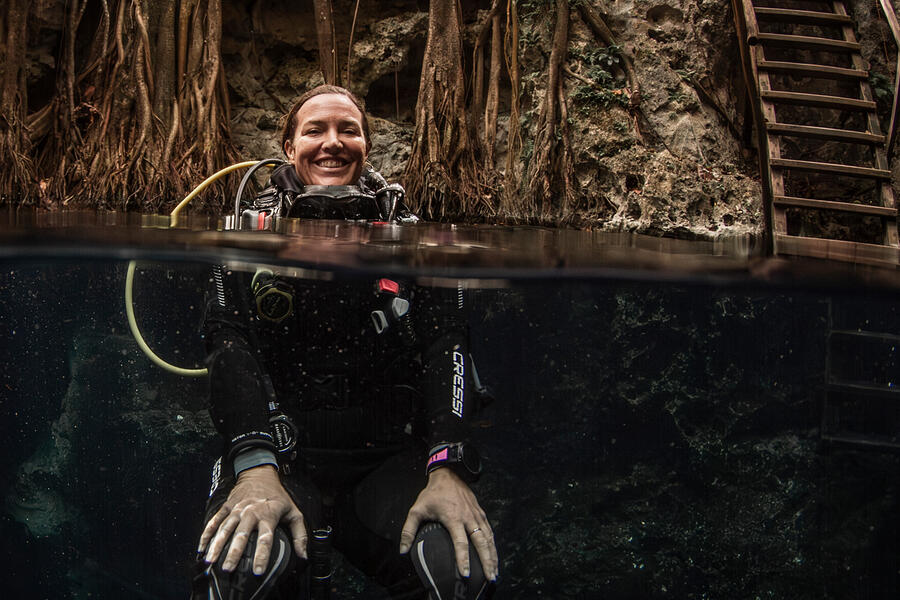When Emily Henson is scuba diving below the ocean surface—sometimes as deep as 130 feet—and surrounded by the colorful splendor of marine life, there is only one way to describe it.
"The experience is totally immersive and meditative," she says. "You are in an environment not normally hospitable to human life, which makes it incredibly humbling. You're very aware that you're a guest and just how special that is. You're also completely removed from your phone, which is a rare gift these days. The world isn't being filtered or presented to you by an algorithm. It's just you and the fish. And I find that very peaceful and calming."
Henson is new to Johns Hopkins University, having joined in August as director of Communications for Provost Ray Jayawardhana. As such, she is responsible for developing and implementing comprehensive communication strategies to support initiatives and priorities from the Provost's Office. She is also the provost's primary speech writer.
But in her life outside the university, she embraces the chance to tether herself to a self-contained breathing apparatus and sink deep into the water, where "I find joy, peace, and a sense of wonder," she says.
"When I'm underwater, the world above totally recedes, and it forces me to be fully and completely present in a way that nothing else does," she says. "It's very perspective giving in that way. All the things I worry and stress about above water are put into a greater context when faced with the vastness of the ocean."
She keeps a disconnect between her ocean explorations and her job, "even though it's not at all uncommon that a good idea comes to me underwater," she says. Still, diving is not a pastime she engages in to enhance her work performance or improve her productivity or effectiveness. "Rather, it's taught me the value of my own joy and making space for that in a world that too often only defines us by external markers of achievement," she says.
"So few adults I know do hobbies just for pleasure, for our own enjoyment," she adds. "And for me that's what diving is. It's a way for me to live a bigger, happier, more expansive life. If any of that goodness happens to spill over into my professional life, then great. But that's not a goal for me. It's about chasing my own sense of joy and wonder at the extraordinary beauty of the world while I'm lucky enough to be here."
To that end, she marvels at the coral reefs, the marine landscapes, and the stunning variety of fish, even the occasional shark that circles her.
"Sharks are incredible," she says. "They really don't care about you. You just need to be smart and maintain awareness. One of the first rules of diving is never touch marine life. Sharks aren't looking to harm you. They just swim around you, although it can be very adrenaline inducing. It's thrilling, really."
Before coming to JHU, Henson had taken a year's sabbatical—what she calls "the year of fun"—after eight years as deputy chief of staff for the dean of the Faculty of Arts and Sciences at Harvard University, leaving in June 2023. She traveled around the world to engage in exotic dives and other adventures, an itinerary guided in part by "bucket list" diving locations. "It was something I'd wanted to do for many years, and the moment was right," she says.
Among other things, she had long wanted to walk the Camino de Santiago, the 500-mile ancient pilgrimage route in northern Spain. It took her about a month, walking 15 to 18 miles a day on one of the more popular Comino routes. "I did the French route, which starts in a small town in the French Pyrenees called St.-Jean-Pied-de-Port and ends in Santiago de Compostela, a town in northwest Spain."
After the walk, she traveled to Egypt to dive in the Red Sea, then to the Maldives in the Indian Ocean to dive with tiger sharks—among the most aggressive in the species—and eventually to the Philippines to finally see the elusive thresher shark, her favorite.
But she calls the two weeks she spent diving at Raja Ampat, a remote Indonesian archipelago located in the southwest Papua province, as "the crown jewel of my trip."
It forms part of the Coral Triangle, which offers some of the world's most pristine reefs and the most marine biodiversity on the planet, including more than 3,000 species of fish and 75% of the world's known coral species, she says. "If you ask 10 divers where they would most want to dive in the world, I bet at least nine of them would say Raja Ampat."

Image caption: Henson takes a sunset selfie in the Maldives in the Indian Ocean.
Image credit: COURTESY OF EMILY HENSON
Henson first became interested in diving during a 2018 vacation trip to Malta with her best friend. They stayed at an Airbnb whose host happened to be a dive instructor who was taking a group of other guests on dives that week. She and her friend spent their days hanging out on the beach, "but every night at dinner we would hear about the dives they did that day," she recalls. "We would say, Why would anyone do this? That is crazy."
But by the time their week's stay was ending, they were admittedly intrigued. They told the instructor they would get certified and come back in a year if she promised to take them scuba diving for a week. They did—and she did.
"I just totally fell in love with it," she says. Since becoming certified in 2019, she has completed more than 700 dives.
Certification involves attending classes over a few days and demonstrating certain water skills, first in confined water—usually a pool—followed by four open water dives with an instructor.
Divers must learn basic skills such as how to properly use and read their dive equipment, as well as a routine set of hand signals used to communicate underwater. They also must learn to deal with common issues, such as how to clear their mask if water gets in. They also learn lifesaving skills they might need in case of an emergency, such as equipment malfunction, or what to do if they or their buddy runs out of air. (Divers always dive with a buddy, never alone.)
Running out of air is a rare event, but "generally, if you are the one out of air, you get your buddy's attention and give them the out-of-air signal, and then they give you their secondary regulator," the device you breathe from, she says. "Then you end the dive and ascend." Basically, "it's how to keep yourself safe underwater," she says.
"I have never had my equipment malfunction, but I have definitely been in some tricky situations I had to learn how to navigate, like how to handle myself in currents," she says. "Early in my diving days, my best friend and I got separated from our group because we got caught in a super strong current. It scared me at first, but we both calmed ourselves and worked our way out of it safely. We knew not to try and work against the current—you'll never win that. So, once we had lost sight of the group, we stayed close together as we drifted, inflated our surface marker buoy, and slowly ascended."
There aren't any locations near or around Baltimore where she dives, she says, "but I do frequent the [National] Aquarium to get my fix," she says. She prefers traveling to diving locations outside the country; in fact, Key West, Florida, is the only U.S. site where she has gone diving.
Still, she tries to indulge in her passion for diving whenever she can, convinced it helps keep her life in balance.
"Everything just slows down. It's a very tranquil kind of activity," she says. "Everything is stripped down to basics. You just have to breathe. I just love how elemental it feels. Also, I really do love the sharks."
My Other Life is a recently launched At Work series that lets us get to know our Johns Hopkins colleagues better. Do you or one of your co-workers have a personal passion that would make a good story? Let us know at hubatwork@jhu.edu.
Posted in News+Info
Tagged my other life









